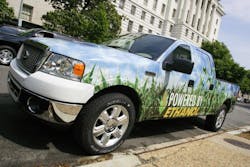The report – compiled under the auspices of the University of Nebraska-Lincoln (UNL) – casts doubt on whether corn residue can be used to meet federal mandates to ramp up ethanol production and reduce greenhouse gas emissions – that’s according to Adam Liska, a UNL assistant professor who led the research team for this particular study.
Liska's study – funded through a three-year, $500,000 grant from the U.S. Department of Energy – used carbon dioxide measurements taken from 2001 to 2010 to validate a soil carbon model built using data from 36 field studies across North America, Europe, Africa and Asia.
Using U.S. Department of Agriculture soil maps and crop yields, UNL’s team extrapolated potential carbon dioxide emissions across 580 million 30-meter by 30-meter "geospatial cells" in so-called “Corn Belt” states – showing that the states of Minnesota, Iowa and Wisconsin in particular had the highest net loss of carbon from residue removal because they have cooler temperatures and more carbon in the soil.
The team then used a supercomputer model at UNL's Holland Computing Center to estimate the effect of residue removal on 128 million acres across 12 Corn Belt states – and they found that removing crop residue from cornfields generates an additional 50 to 70 grams of carbon dioxide per “mega-joule” of biofuel energy produced – with a joule roughly equivalent to 1 British Thermal Unit or BTU – with total annual cellulosic ethanol production emissions, averaged over five years, equaling about 100 grams of carbon dioxide per mega-joule.
That’s 7% greater than gasoline emissions and 62 grams above the 60% reduction in greenhouse gas emissions as required by the 2007 Energy Independence and Security Act, Liska said.
"If less residue is removed, there is less decrease in soil carbon, but it results in a smaller biofuel energy yield," he added, noting that UNL’s team tried “without success” to poke holes in its findings."If this research is accurate, and nearly all evidence suggests so, then it should be known sooner rather than later, as it will be shown by others to be true regardless," Liska explained. "Many others have come close recently to accurately quantifying this emission."
He also pointed out that the study's findings likely will not surprise farmers, who have long recognized the importance of retaining crop residue on their fields to protect against erosion and preserve soil quality.
Now, Liska did note that UNL’s research team found ways to mitigate increased carbon dioxide emissions and reduced soil carbon, such as by planting cover crops to fix more carbon in the soil.
Cellulosic ethanol producers also could turn to alternative feedstocks, such as perennial grasses or wood residue, or export electricity from biofuel production facilities to offset emissions from coal-fueled power plants, he added.
UNL’s research isn’t taking potshots at biofuels solo, either, as the most recent report from the United Nation’s Intergovernmental Panel on Climate Change (IPGC) noted that “indirect” carbon emissions from biofuel production can overshadow reductions made when burning of such fuels to power motor vehicles. (Click here for a story about this in Forbes magazine.)
One thing is for sure – both of these reports are going to ramp up the debate over the future of several biofuel options being touted for motor vehicles in the future.





